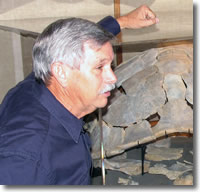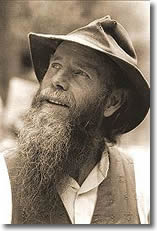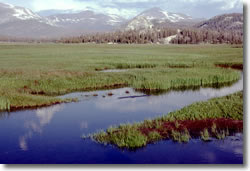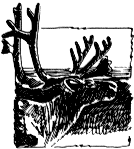Lectures 2001
January 26California's Heritage Trout - A Resource in Peril
by David Lentz, California Department of Fish and Game
California's native trout diversity includes three subspecies of cutthroat trout, three forms of golden trout, several redband trout, and the familiar coastal rainbow trout. The bull trout has been lost—no longer in its native McCloud River. Other species like German brown and brook trout have been introduced to California water where they have affected native species in numerous ways.
David Lentz is a fishery biologist working for the Wild Trout Project since 1989. He coordinates wild trout management statewide, working with biologists from state and federal agencies as well as with fishing clubs and organizations. His slide-illustrated presentation will focus on the status of our native trout and their conservation. Lentz will discuss efforts to conduct statewide inventories of trout streams and the monitoring of wild trout waters. Angling opportunities for native trout and restoration efforts will also be discussed. As Project Leader, Lentz coordinates the program that manages more than 1080 miles of streams and 19 lakes in California.
February 23Dinosaurs and Other Mesozoic Reptiles of California
by Dick Hilton, Sierra College Professor, Geology
 Dinosaurs in California? Many people are not aware that there have been numerous discoveries of dinosaurs, pterosaurs, ichthyosaurs, mosasaurs, plesiosaurs, and other sea going reptiles that once lived in California. Dick Hilton, Professor of Geology at Sierra College has spent his career both teaching and exploring. His explorations have added some exceptional "finds" to the list of California discoveries.
Dinosaurs in California? Many people are not aware that there have been numerous discoveries of dinosaurs, pterosaurs, ichthyosaurs, mosasaurs, plesiosaurs, and other sea going reptiles that once lived in California. Dick Hilton, Professor of Geology at Sierra College has spent his career both teaching and exploring. His explorations have added some exceptional "finds" to the list of California discoveries.
This slide-illustrated presentation will bring these and many other discoveries to light. It will highlight the histories of the people who have discovered, researched, and published about Mesozoic reptiles. Photographs will chronicle a century of discovery and Ken Kirkland's life-like artwork will bring these bones to life. Join us for a journey into the ancient past—a time when California was dominated by reptiles.
March 30Winged Predators
by Brian T. Farrell
As a middle school teacher, Brian Farrell has used live birds of prey to awaken environmental curiosity and concern for nature in his students. His own interest began more than 25 years ago when he acquired his first bird of prey. In his career (both teaching and demonstrations given "on the road") he has thrilled more than 100,000 young people with live demonstrations and conservation seminars. Using three North American birds of prey, Brian, a licensed Master Falconer, will make such a presentation to the museum audience.
The Gyrfalcon (the world's largest falcon from the Arctic and the most prized bird in falconry), a Ferruginous Hawk (the world's largest hawk), and a Harris Hawk (once extinct in California, but slowly making a comeback), will be flown. Included in his presentation will be ecological information of common and endangered species, the importance of viable habitat and a history of falconry. Don't miss this spectacular show!
April 20Conversation With a Tramp: An Evening With John Muir
by Lee Stetson as John Muir
 This stirring production has been presented every summer in Yosemite National Park—and throughout the country and around the world as well—since 1983. It depicts Muir's last dramatic battle to preserve the beautiful Hetch Hetchy Valley, part of Yosemite National Park, but threatened by San Francisco's desire to construct a dam there, drowning it hundreds of feet deep.
This stirring production has been presented every summer in Yosemite National Park—and throughout the country and around the world as well—since 1983. It depicts Muir's last dramatic battle to preserve the beautiful Hetch Hetchy Valley, part of Yosemite National Park, but threatened by San Francisco's desire to construct a dam there, drowning it hundreds of feet deep.
Audience members are captivated as his guests—they await final word of the Hetch Hetchy's fate from Washington decision makers. While waiting, Muir's righteous anger at the "temple destroyers" is tempered by his hearty good humor. He relates a number of his most extraordinary wilderness adventures, including his remarkable "tree ride" in a Sierra windstorm. This powerful performance is a fine introduction to both Muir, the man, and his profound love of wildness.
May 18The Sierra Nevada
by Joe Medeiros, Sierra College Professor, Biological Sciences
 Called the Range of Light by John Muir, California's premier mountain range was named "La Sierra Nevada" or the snowy range by early Spanish missionaries. Four hundred miles long and more than 2 1/2 miles tall, it is the home of the world's largest trees (Giant Sequoias) and is carpeted by rich forests of conifers and broadleaf trees. From its highest glacially-carved granite peaks to its deep-soiled foothills, the Sierra has provided humans with riches and resources and a pivotal place in American history.
Called the Range of Light by John Muir, California's premier mountain range was named "La Sierra Nevada" or the snowy range by early Spanish missionaries. Four hundred miles long and more than 2 1/2 miles tall, it is the home of the world's largest trees (Giant Sequoias) and is carpeted by rich forests of conifers and broadleaf trees. From its highest glacially-carved granite peaks to its deep-soiled foothills, the Sierra has provided humans with riches and resources and a pivotal place in American history.
Join Sierra College biologist Joe Medeiros in a slide-illustrated celebration of our nearby mountains. From incredible winter storms with deep snows to balmy summer backpacking we'll review the many aspects, biological and physical that makes this place so special. Migratory birds, rare mammals, and unique amphibians are among the topics discussed as we celebrate the past and present of the Sierra, as well as plan and prepare for its viable and sustainable future.
September 28Arctic National Wildlife Refuge: Should We or Shouldn't We Drill for Oil?
by Randy Bailey
 At nearly twenty million acres, one-fifth the size of California, the Arctic National Wildlife Refuge is among the most complete, pristine, and undisturbed ecosystems remaining on Earth. This American treasure chest supports 180 species of birds, 36 land mammals, nine marine mammals and 36 fishes. Spreading northward and including Alaska's Brooks Range it has no roads, no developments and no trails. The current Bush administration is pressing aggressively to open 1.5 million of its acres to oil and gas development.
At nearly twenty million acres, one-fifth the size of California, the Arctic National Wildlife Refuge is among the most complete, pristine, and undisturbed ecosystems remaining on Earth. This American treasure chest supports 180 species of birds, 36 land mammals, nine marine mammals and 36 fishes. Spreading northward and including Alaska's Brooks Range it has no roads, no developments and no trails. The current Bush administration is pressing aggressively to open 1.5 million of its acres to oil and gas development.
Randy Bailey spent nine years as Chief of the US Fish and Wildlife Service's Division of Fisheries in Alaska—supervising three field stations with a permanent staff of 30 biologists. His slide-illustrated presentation will provide an overview of Alaskan ecosystems and landscapes and a focus on oil development along the North Slope, from Prudhoe Bay to the Canadian Arctic. How might new exploration affect the Arctic National Wildlife Refuge? Do we have the technology to do it without the destruction of an irreplaceable natural treasure? Randy Bailey will provide a professional biologist's perspective.
October 26Global Population and the Environment
by Karen Gaia Pitts
During 2000 and 2001 Karen Gaia Pitts traveled in several Asian countries with a mission to observe the human condition as it relates to the environment. She spent two weeks on a trek in mountainous Nepal only to discover that the Himalayan forests were disappearing as Nepalese walked farther and farther for firewood and cattle fodder. Resultant soil erosion was rampant. Later, in Bangladesh, a Muslim country that ranks as the most densely populated in the world she observed the lives of its inhabitants, their burgeoning population and their similar struggle with sustainability. But also in Bangladesh she discovered a successful family planning and women's health program and brought its symbol home—the Green Umbrella—hoping to encourage more U.S. funding for such programs. Karen's slide-illustrated program highlights these and other stops along her travels: Thailand, India, and Burma—all densely populated countries with similar resource problems.
Karen is a native Californian, currently population chairperson of the Motherlode Chapter of the Sierra Club and a member of the National Global Population and Environment Program Committee. She is founder of the Green Umbrella Campaign and web publisher of www.population-awareness.net
November 2Chasing California Tornadoes
by Steve Johnson
Think there aren't any tornadoes in California? Meet Steve Johnson, California's premier tornado chaser! Using state-of-the-art technology and advanced forecast techniques, Johnson has an astonishing record for finding funnel clouds and tornadoes in California. He likes nothing better than driving hundreds of miles for the opportunity to be close to a tornado when it touches down. His adventures in tornado chasing have prompted other scientists to look more closely at California tornadoes. He will discuss his adventures in tornado chasing in California and other states. He'll show video of some of his exploits and give tips for those who share his fascination with some of nature's most violent weather.
This program is cosponsored and brought to the museum by the Sacramento Chapter of the American Meteorological Society.
November 30A Trek Across China
by Sean Booth
China is a land of amazing diversity. It is the world's third largest country in land area, after Russia and Canada. With more than one billion inhabitants, it is the most populous nation on Earth. Its geography comprises many of the world's tallest mountains, the driest deserts, the most expansive grasslands, and a great diversity of climates. China has over 50 distinct ethnic groups that speak their own language and practice their own folkways.
This discussion and slide show explores a transect of China from south to north, looking closely at the physical and cultural landscapes of China from a personal vantage point. Many stories will be told about adventurous travel, language difficulties, colorful ethnic minority groups such as the Bai and Tibetan people, daily nuisances, political climate, and the geography of China—a land of diversity.
November 10-11Birds of Prey Workshops
The museum is cosponsoring a two-day raptor workshop with the California Foundation for Birds of Prey at Sierra College. Numerous speakers will present topics on raptor medicine, conservation and rehabilitation on Saturday. Hands-on workshops (captive raptor health and field identification) will take place on Sunday.
